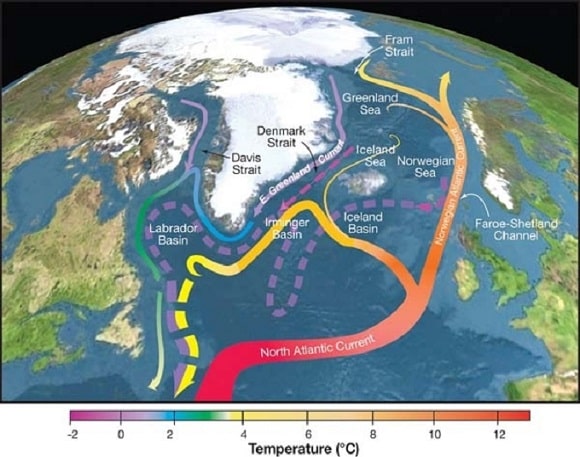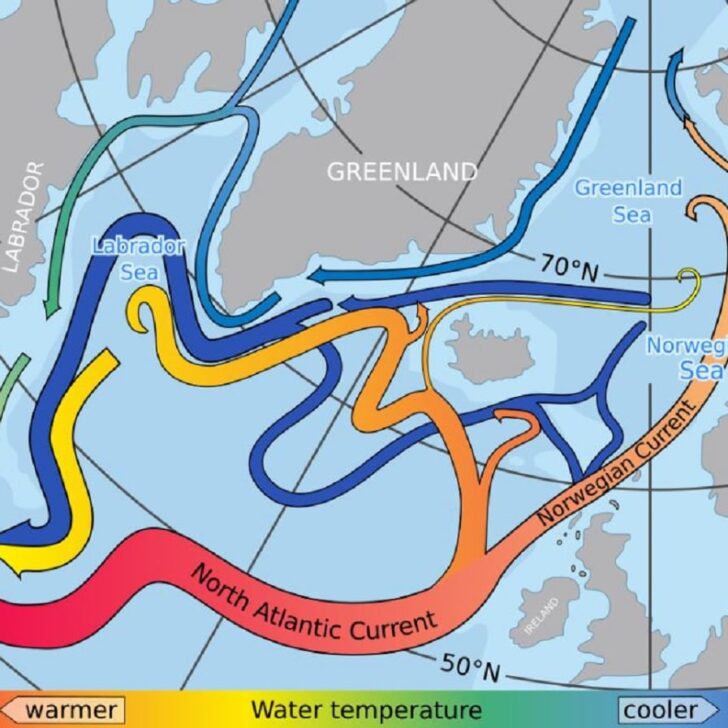In a chilling open letter, climate scientists have urged the Nordic Council of Ministers to act immediately in response to the escalating risk of a collapse in the Atlantic Meridional Overturning Circulation (AMOC), a crucial ocean current that regulates temperature and weather patterns in the Northern Hemisphere.
The letter warns that the potential for this tipping point is far greater than previously thought, with devastating consequences not just for the Nordic region but for the entire planet.
We took a closer look at the open letter and all the risks associated with a collapsed Atlantic Meridional Overturning Circulation.
The AMOC: A Critical Climate Regulator
The AMOC is a massive ocean circulation system responsible for transporting warm water from the tropics to the North Atlantic. Its influence is felt across Europe, the Arctic, and beyond, regulating weather patterns and sustaining ecosystems.
Recent scientific studies suggest that this system is under greater threat than earlier estimates, with the possibility of collapse within the next few decades.
If the AMOC fails, the consequences would be disastrous for global climate stability.
According to the open letter, the Arctic region, including the Greenland Ice Sheet and boreal permafrost systems, is particularly vulnerable to nonlinear climate shifts that could trigger a cascade of irreversible changes.
The AMOC, which drives much of the heat transfer in the North Atlantic, is at the center of these concerns.
Growing Scientific Consensus

The letter aligns with findings from the latest research on the weakening of the Gulf Stream, a key component of the AMOC.
Recent research underscores that it is now “99% certain” that the Gulf Stream is weakening—a trend that scientists have been tracking for decades.
The weakening of this current has far-reaching global consequences, including shifts in weather patterns, altered ecosystems, and impacts on global food supplies.
The scientists in the letter highlight the IPCC’s (Intergovernmental Panel on Climate Change) acknowledgment of the possibility of an AMOC collapse, though they note that the IPCC’s “medium confidence” rating for this event occurring before 2100 is not reassuring enough.
Emerging research indicates that the risk of a tipping point may have been significantly underestimated, with a collapse possible within the coming decades.
The impacts of such a collapse would be felt globally, including more extreme weather, disruptions to marine ecosystems, and severe consequences for agriculture.
Consequences for the Nordic Region
For Nordic countries, the effects of an AMOC collapse could be particularly catastrophic.
The region could experience significant cooling as the rest of the world warms, which would exacerbate the already existing “cold blob” in the North Atlantic.
This would lead to unprecedented extreme weather events, threatening the viability of agriculture across northern Europe.
Livelihoods, infrastructure, and food security could be drastically altered in these regions, with ripple effects felt across global markets.
The potential global impacts are also dire. A weakened or collapsed AMOC would lead to reduced oceanic carbon dioxide uptake, which could speed up the accumulation of greenhouse gases in the atmosphere.
Rising sea levels, especially along the Atlantic coast of the United States, shifts in tropical rainfall belts, and marine ecosystem upheavals are also likely outcomes.
Global fisheries could face massive disruption, exacerbating food shortages and destabilizing economies.
A Call to Urgent Action
The letter urges the Nordic Council of Ministers to take immediate steps to assess the risk of an AMOC collapse and to act swiftly to mitigate it.
The scientists argue that adaptation alone will not be sufficient to counteract the impacts of such a collapse.
Instead, they recommend leveraging the Nordic countries’ strong international standing to advocate for more aggressive global efforts to reduce carbon emissions.
Given the increasing evidence of a higher likelihood of AMOC collapse, the scientists warn that waiting for more certainty is a dangerous gamble.
With even “medium confidence” in the possibility of collapse within this century, the outcome would be catastrophic for the entire world, and the consequences would play out for centuries.
FAQ: Understanding the Atlantic Meridional Overturning Circulation (AMOC)
What is the AMOC?
The Atlantic Meridional Overturning Circulation (AMOC) is a large system of ocean currents in the Atlantic Ocean, driven by differences in temperature and salt concentration.
The AMOC transports warm, salty water from the tropics to the North Atlantic, where it cools, sinks, and flows back south at deeper levels.
This process plays a vital role in regulating climate and weather patterns, especially in the Northern Hemisphere.
How does the AMOC affect the climate?
The AMOC acts like a conveyor belt for heat in the Atlantic Ocean, helping to moderate temperatures in Europe and the Arctic.
It distributes warm tropical waters to northern latitudes, which influences weather patterns, marine ecosystems, and even the jet stream.
A stable AMOC is critical to maintaining the relatively mild climate of northern Europe and much of the North Atlantic region.
What causes the AMOC to weaken or collapse?
The AMOC is driven by differences in water density, which are affected by temperature and salinity.
Climate change is causing freshwater from melting ice in Greenland and the Arctic to enter the North Atlantic, diluting the salty water and reducing its density.
This disruption slows down the sinking of water that drives the AMOC.
If too much freshwater enters the system, the AMOC could weaken substantially or collapse entirely, leading to a major shift in global climate.
What are the consequences of an AMOC collapse?
An AMOC collapse would have severe and far-reaching consequences. It could lead to:
- Significant cooling in northern Europe despite global warming, as the flow of warm water to the region is disrupted.
- Unprecedented extreme weather patterns and more frequent cold spells in Europe.
- Changes in global rainfall patterns, including shifts in tropical rain belts.
- Major sea level rise along the eastern coast of North America due to the buildup of water from weakened ocean circulation.
- Disruptions to marine ecosystems and fisheries, impacting food supplies and economies.
Global consequences could also include accelerated atmospheric carbon dioxide buildup, contributing to faster climate warming.
How likely is an AMOC collapse?
According to the IPCC, there is “medium confidence” that the AMOC will not collapse abruptly before 2100. However, recent research suggests the risk may be higher than previously thought.
Some studies estimate that there is a significant possibility of an AMOC tipping point within the next few decades.
While uncertainties remain, the consequences of such a collapse would be catastrophic, and scientists stress the need for urgent action to mitigate this risk.
What can be done to prevent an AMOC collapse?
Reducing global carbon emissions is the most effective way to mitigate the risk of an AMOC collapse.
By limiting global warming, we can slow the melting of Arctic ice and the influx of freshwater into the North Atlantic, helping to stabilize the AMOC.
The scientists in the open letter call for immediate global action to reduce emissions, alongside focused studies on understanding and managing the risks associated with this critical ocean circulation system.
Sources Used in This Article
- Open Letter from Climate Scientists to the Nordic Council of Ministers
- Key Atlantic current could collapse soon, ‘impacting the entire world for centuries to come,’ leading climate scientists warn
- Live Science: Gulf Stream Weakening Now 99% Certain and Ramifications Will Be Global
- Wikipedia: Atlantic Meridional Overturning Circulation (AMOC)

